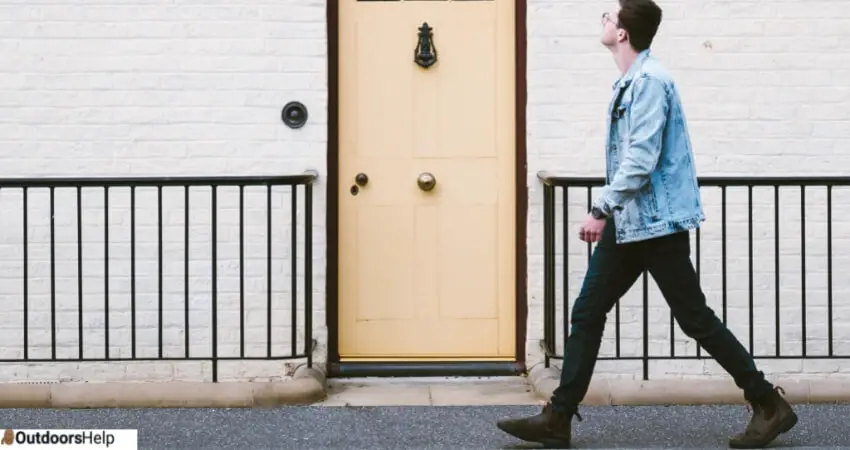Did you know how you walk says a lot about your personality? It turns out that the way you walk or stroll conveys a lot about your character without your knowledge. According to the latest analysis, a quicker pace is associated with increased extraversion, conscientiousness, openness, and reduced neuroticism. According to studies, the average adult walking speed is slightly over 3 miles per hour.
What is Walking Speed?

Walking speed (or gait velocity) is the primary metric that characterizes a person’s basic walking ability. In mathematics, we describe speed as the distance covered over time taken. So, walking speed is the amount of time it takes a person to walk a certain distance.
The term velocity is both the speed and the direction in which something is moving. The contrast between speed and velocity is irrelevant because walking is usually assessed in the forward direction.
However, because that benchmark ignores numerous factors, let’s take a deeper look at typical walking speeds.
A Table Illustrating Average Walking Speed By Age And Gender

| Gender and Age | Average Casual Walking Speed | Average Maximum Walking Speed |
| Men 20-29 | 3.12 mph | 5.57 mph |
| Men 30-39 | 3.26 mph | 5.49 mph |
| Men 40-49 | 3.27 mph | 5.51 mph |
| Men 50-59 | 3.12 mph | 4.63 mph |
| Men 60-69 | 3.04 mph | 4.32 mph |
| Men 70+ | 2.98 mph | 4.65 mph |
| Women 20-29 | 3.15 mph | 5.52 mph |
| Women 30-39 | 3.17 mph | 5.24 mph |
| Women 40-49 | 3.11 mph | 4.75 mph |
| Women 50-59 | 3.12 mph | 4.50 mph |
| Women 60-69 | 2.90 mph | 3.97 mph |
| Women 70+ | 2.85 mph | 3.91 mph |
How to Calculate Your Average Walking Speed
The technique to accurately calculate walking pace is translating the distance into miles and the time into hours. Then you should divide the number of miles by the number of hours to get the average walking pace in miles per hour.
To get the accurate distance covered, you should use a ‘Pedometer.’ This electric device attaches to your pants or belt and counts how many steps you take. It detects your movement while you walk and counts the steps you take. Basic pedometers count the number of steps taken. More advanced models track distance, time, or calories burned.
You can also use a smartwatch or a tracking device to measure your distance. This is a more effortless and effective method to calculate your distance and fitness levels, and this gadget can readily assess your walking pace. Furthermore, many of these devices measure your heart rate, allowing you to walk at the proper speed to burn calories and get better exercise.
Do you want to measure your average walking speed without measuring the distance and the time? Get a radar gun. Radar employs radiofrequency to estimate the distance and velocity of an item of interest.
When you point the speed gun towards the person you wish to inspect, the readout displays the person’s speed. These radars generally contain a laser pointer so you can see where it’s directed. Aim at the torso rather than swinging arms or moving legs to obtain a proper assessment of walking speed.
You can use an innovative stand-alone accurate radar gun with an app on iOS and Android devices.
It calculates exit velocities, walking speeds, shooting speeds, and serving rates and may be displayed in bright red LED on your iOS or Android device and stated through a speaker.
It also captures auto-edited videos showing your speed that you can send through email, text message, or social media platforms using the free Pocket Radar App, which connects to the Smart Coach gadget over Bluetooth.
Additionally, the device tracks data over time in your history and exports it to a CSV file to monitor your progress. This device is compatible with the Free Pocket Radar App on Apple and Android devices.
Factors Affecting Your Average Walking Speed

several characteristics influence a person’s preferred walking pace, for instance:
1. Age: Younger folks walk faster than their elders.
2. Gender: Men are somewhat quicker walkers than women.
3. Overall health: Your genetics, food, and medical issues influence your walking speed.
4. Body size: Your speed is affected by limb length and body mass index (BMI).
5. Fitness level: You may realize a faster walking speed as you exercise more.
Crowds, other natural obstacles, and the terrain are all variables. When climbing hills, people walk more slowly, and when descending, they walk faster. Walking is defined as an “inverted pendulum” stride in which the body swings over a rigid leg with each step. Unlike running, at least one leg remains in touch with the ground at all times.
How to Improve Your Walking Speed
If you detect that you are walking slower than usual, you may employ a few tactics to keep your walking speed at an efficient level.
1. The first method focuses on the structural changes in your body as you age. It’s critical to figure out how to better these structural alterations; these bodily components are the machinery that allows you to move.
Alterations in muscular strength in our legs and torso, which we require to support ourselves when we walk, are among these structural changes. Your joints must also be flexible for your muscles to move your limbs efficiently, such as the length of the steps you take when walking.
The inability to stretch your leg behind you so that you can walk forward is one example of a change in our bodily structures you could observe. You should include the following exercises to improve your structure;
a) To increase the strength of the leg muscles utilized during walking: Stand and sit on a chair regularly—practice standing near support, rising onto your toes, and back on your heels.
b) To increase the flexibility of your leg’s joints: While you stand on the edge of a step, hold yourself with your arms, depress your heel, and lie on your (left) side. Raise and move your right leg rearward as far as you can. Maintain the posture for a moment before returning it. Repeat on the other side.
2. The second strategy for increasing walking speed is to train your brain to walk more effectively.
Walking is improved through practice, which restores the brain pattern that allows the muscles and nerves to match better the demands of walking. You require a baseline fitness degree involving your cardiorespiratory system to walk efficiently. This implies that you don’t get out of breath when walking and that oxygen gets to the muscles quickly.
Walking requires a lot of energy; therefore, you’ll do it less often than those who don’t get weary when walking. When your brain, muscles, joints, and nerves respond more effectively to the walking demands, your average walking speed improves tremendously. Skilled walkers have a more efficient approach to walking, are more inclined to walk longer distances, and have fewer difficulties moving.
Conclusion
Walking is an excellent exercise that helps us lose calories, stay in shape, and improve our mental health. If you desire and are determined to lose those extra pounds and look younger than you are, get on the move, and start walking. While at it, try to attain the average walking distance that conforms to your age bracket.
Reference 1: Average Walking Speed: Pace, and Comparisons by Age and Sex (healthline.com)
Reference 2: Average Walking Speed by Age: How Does Yours Stack Up? (greatist.com)

